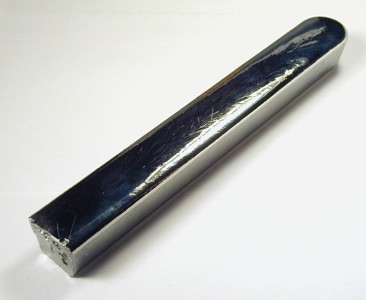Welcome to Metallium's Photo Gallery
Here you will find photos of unusual or custom pieces that have been made special for select customers. This is a showcase of the capabilities we have to produce special items to customer's specifications. If you are interested in having similar pieces made by us, simply send an email and let us know what you would like. We may be able to make it for you!
Most of these pieces were made by the arc-casting process. See a detailed description of this manufacturing process by scrolling down this page.
A 100-gram piece of iridium. It is over 1 inch in diameter (25mm) and feels incredibly heavy in the hand as well as being a beautiful piece to view:

Here is another custom-made piece, a 140-gram Ruthenium bar. It is over 2 inches long and over 1/2 inch in diameter:

These are 1-kilogram cast ingots of Gadolinium and Samarium, respectively, cast special for a customer. They are over 4 inches in diameter:


A 1-kilogram (2.2 pounds) bar of pure Germanium metal (about 1 foot long):

A perfect Osmium 10-gram piece even made it into a ring:

Following is a stunning series of rods made of several pure metals. (Click on each photo for a larger image). The first is one made of solid gold weighing over 19 troy ounces (over 1 pound!). One half of these rods was polished to a mirror finish with the other half left in an unfinished state.


This one is of solid Platinum weighing over 21 troy ounces. At the time of the sale of this piece the market value of the metal in this piece was over $18,000.00.


This one is Palladium weighing 12 troy ounces.


Here's one made of Iridium at over 22 troy ounces. This rod was very difficult to make due to the very high melting point (4400 degrees F) and the extreme hardness and brittleness of the material:


And one of Ruthenium at 12.5 troy ounces. Like iridium, ruthenium has a high melting point and is extremely hard making the material difficult to fabricate into a rod:


A larger rod made of pure Tin weighing 1 kilogram:

One made of Antimony weighing 1 kilogram. Polished antimony exhibits a brilliant, deep crystalline structure:

And a 1-kilogram rod of Bismuth:

On a different note, here are samples of elements preserved in clear plastic resin. The first one is Bromine sealed in a glass ampoule within the plastic and the second is a crystalline disc of Tellurium:


A Brief Description of the Arc-Casting Process
This process is used either to obtain the appearance of a smooth and shiny arc-cast pellet or in some cases because of extremely high melting points (iridium, osmium and others).
In a nutshell the arc-casting process works like this:
- The raw metal material (powder, sponge, etc.) is measured on a gram scale and placed in a copper or graphite mold within the arc-melting chamber.
- The arc-melting chamber is then sealed and evacuated with a vacuum pump to create a vacuum inside the chamber. The chamber is then back-filled with Argon gas, which is a completely chemically inactive gas. This gas will ensure that the metal piece being melted will not have any air (oxygen and nitrogen) to react with during melting.
- Electrical current is then passed through a tungsten electrode inside the chamber which is positioned close to the metal being melted. An electric arc will jump the gap between electrode and metal and will flow through the metal, heating it very rapidly until it melts. The copper or graphite mold are cooled by a continuous flow of water or coolant to ensure that the mold itself does not melt during the arcing process.
- Once the metal is sufficiently melted the current is turned off and the arc-cast piece allowed to cool. After cooling the melting chamber is opened and the piece removed and inspected.
One of the amazing aspects of the arc-cast process is that it can melt almost any metal, including Tungsten which has the highest melting point of any metal (at over 6192 degrees F or 3422 degrees C). Several other metals that can be melted by the arc-cast process that have melting points over 4000 degrees F include rhenium, osmium, tantalum, iridium and hafnium. Some arc-cast pellets will show voids in the center of the piece. This is the effect of rapid cooling and thermal contraction of the liquid metal upon solidification.
Note that for precious metal arc-cast pieces selling prices are higher than the market price of the raw metal due to the cost of the labor and equipment of casting these pieces. This is analogous to silver bars and gold bullion coins which typically sell for a few cents or dollars above the daily quoted spot market price for these metals due the cost of fabrication.
The arc-melting process produces cast pieces of a purity that is equal to, or better than the purity of the original raw material.
The arc-cast pellets offered on this site are cast in a spherical mold to create the button shape. The mold can be fabricated to create other cast shapes, such as rectangular bars or flat disks.
Back to Main Page



















